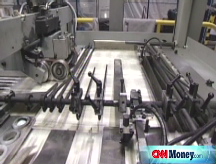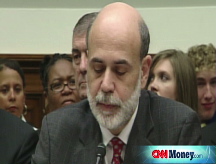Credit markets ease on Fed move
The Federal Reserve unveiled a plan to buy up short-term corporate debt. The 3-month yield surges to near 1%.
NEW YORK (CNNMoney.com) -- Credit markets eased slightly Tuesday after the Federal Reserve announced plans to help unclog the pipeline by buying up short-term corporate debt that is typically used to cover day-to-day business expenses.
The move is seen as a positive for lenders because the Fed's intervention means companies will be able to cover short-term debts, including payrolls. Previously, large companies had funded these daily expenses through the commercial paper market, but with the credit pipelines frozen, that source has dried up.
The Fed is filling in "a big crack" in the credit crisis, said William Larkin, portfolio manager at Cabot Money Management. "It is a step in the right direction," he said. "We don't know what the benefit will be, but there will be a benefit."
The short-term credit markets reacted immediately, with the yield on the 3-month note surging above 1% - a level not seen since Sept. 22. Prices and yields move in opposite directions so higher yields indicate less demand for the notes.
By late afternoon, the yield retreated to 0.71% but was still much higher than Monday's 0.43%.
The 3-month bill is considered one of the safest assets in times of crisis. Larkin called it "the catastrophe trade" because investors rush to park their assets in areas that may not offer the highest return but do protect the principle in the short term.
The yield had been trending sharply lower as investors poured cash into the 3-month safe haven in recent weeks. As investors gained confidence that the Fed is taking the necessary steps to unfreeze the credit markets, they shifted assets.
"Obviously, this plan is helping to avert some money out of the Treasury market and maybe into other instruments," said Peter Cardillo, chief market strategist at Avalon Partners.
Still, one analyst cautioned that investors shouldn't read too much into the 3-month yield move because the price drop could be attributed to projected surge in supply of the notes. "The government is going to sell 3-month bills, take the proceeds from those 3-month bills and buy the commercial paper," said Andrew Brenner, MF Global senior vice president.
Questions remained about the long-term recovery of the economy. Tuesday afternoon, Federal Reserve Chairman Ben Bernanke said he believes the global financial crisis will extend into next year. He also hinted that the Fed may be getting ready to cut interest rates. The Fed's next scheduled meeting is Oct. 28-29.
Long-term bonds: As the market digests the Fed's latest move and Bernanke's comments, longer-term Treasury prices gyrated.
The benchmark 10-year note fell 12/32 to 104-3/32 and its yield rose to 3.5% from 3.49% late Monday. Bond prices and yields move in opposite directions.
The 30-year bond was down 1 to 108-2/32 and its yield was 4.03%.
The 2-year note ticked higher 2/32 to 101-1/32 and its yield dipped to 1.45% from 1.46%.
The "2-10 yield spread," or the difference between the 2-year and 10-year yields was 2.05%, just more than the 2.03% gap Monday. The spread hardly moved in the past few days, even after the bailout bill was passed, although it narrowed earlier Tuesday just after the Fed's announcement.
Market gauges: Key market indicators suggested that risk aversion was easing. While the overnight London interbank rate (Libor) nearly doubled to 3.94% from 2.37% Monday, it was set before the Fed's corporate bailout announcement. Libor is a daily average of what 16 different banks charge other banks to lend money in London.
The 3-month Libor, also set prior to the Fed news, rose to 4.32% from 4.29% Monday. Both the overnight and 3-month rates remain at levels not seen since January.
One indicator of how willing banks were to lend to other banks, called the "TED spread," showed high prices of loans between banks. The TED spread measures the difference between the 3-month Libor and the 3-month Treasury bill, and is a key indicator of risk. The higher the spread, the bigger the aversion to risk.
The TED spread was at 3.46% Tuesday after reaching a record high of 3.95% Monday. That's quite a leap from a month ago when the TED spread was only 1.04% on Sept. 5.
Another gauge, the Libor-OIS spread, topped 2.86%, easing from an earlier record 2.97%. Libor-OIS measures how much cash is available for lending between banks, and is used by banks to determine lending rates. The bigger the spread, the less cash is available for lending.
Fed steps in: According to a statement from the Federal Reserve, the creation of the Commercial Paper Funding Facility means that the Central Banks would purchase short term debt, also called commercial paper, directly from companies in an effort to jolt the frozen credit markets.
The Federal Reserve's unprecedented move raises inflationary concerns, said Michael Cheah, senior portfolio manager at AIG SunAmerica, because in order to come up with the funds to lend, the Fed has to increase the money supply.
Yet, the move was seen as necessary. "They are intervening into a free market system, but in this particular crisis, if that is what we need to get the ball rolling again, then so-be-it," said Peter Cardillo, chief market strategist with Avalon Partners. "They need to arrest the fear factor," he said. ![]()





